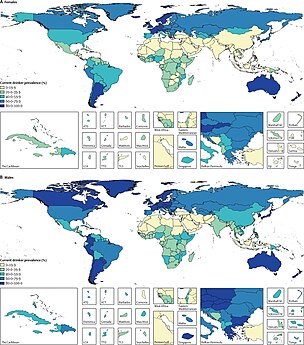Alcoholic beverage

An alcoholic beverage (also called an adult beverage, alcoholic drink, strong drink, or simply a drink) is a
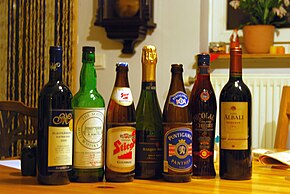
Most countries have
Alcohol is a
History
Prehistory
Discovery of late Stone Age jugs suggests that intentionally fermented drinks existed at least as early as the Neolithic period.[10]
The oldest verifiable brewery has been found in a prehistoric burial site in a cave near Haifa in modern-day Israel. Researchers have found residue of 13,000-year-old beer that they think might have been used for ritual feasts to honor the dead. The traces of a wheat-and-barley-based alcohol were found in stone mortars carved into the cave floor.[11]
Ancient period
Beer was likely brewed from barley as early as the 13,000 years ago in the Middle East.[12] Pliny the Elder wrote about the golden age of winemaking in Rome, the 2nd century BCE (200–100 BCE), when vineyards were planted.[13]
Examination and analysis of ancient pottery jars from the neolithic village of Jiahu in the Henan province of northern China revealed residue left behind by the alcoholic drinks they had once contained. According to a study published in the Proceedings of the National Academy of Sciences, chemical analysis of the residue confirmed that a fermented drink made of grape and hawthorn fruit wine, honey mead and rice beer was being produced in 7000–5600 BC (McGovern et al., 2005; McGovern 2009).[14][15] The results of this analysis were published in December 2004.[16]
The earliest evidence of winemaking was dated at 6,000 to 5,800 BCE in Georgia in the South Caucasus.[17]
Celtic people were known to have been making types of alcoholic cider as early as 3000 BC.[18][19] and wine was consumed in Classical Greece at breakfast or at symposia, and in the 1st century BC.[20]
Medieval period
Medieval Middle East
Medieval
Medieval Europe
In Italy, the works of Taddeo Alderotti (1223–1296) describe a method for concentrating alcohol involving repeated fractional distillation through a water-cooled still.[23] By the early 14th century, distilled alcoholic drinks had spread throughout the European continent.[22] Distillation spread to Ireland and Scotland no later than the 15th century, as did the common European practice of distilling "aqua vitae", primarily for medicinal purposes.[24]
Early modern period
in 1690, England passed "An Act for the Encouraging of the Distillation of Brandy and Spirits from Corn" [25] Alcoholic beverages played an important role in the Thirteen Colonies from their early days when drinking wine and beer at that time was safer than drinking water – which was usually taken from sources also used to dispose of sewage and garbage.[26] Drinking hard liquor was common occurrence in early nineteenth-century United States.[27]
The
Modern period
The Rum Rebellion of 1808 was a coup d'état in the then-British penal colony of New South Wales, staged by the New South Wales Corps in order to depose Governor William Bligh. Australia's first and only military coup, its name derives from the illicit rum trade of early Sydney, over which the 'Rum Corps', as it became known, maintained a monopoly. During the first half of the 19th century, it was widely referred to in Australia as the Great Rebellion.[28]The alcohol monopoly system has a long history in various countries, often implemented to limit the availability and consumption of alcohol for public health and social welfare reasons.
The alcohol monopoly was created in the Swedish town of Falun in 1850, to prevent overconsumption and reduce the profit motive for sales of alcohol. It later went all over the country in 1905 when the Swedish parliament ordered all sales of vodka to be done via local alcohol monopolies.[29] In 1894, the Russian Empire established a state monopoly on vodka, which became a major source of revenue for the Russian government.
Later in the nineteenth century opposition to alcohol grew in the form of the temperance movement, in the United States, United Kingdom, Canada, Scandinavia and India, and it eventually led to national prohibitions in Canada (1918 to 1920), Norway (spirits only from 1919 to 1926), Finland (1919 to 1932), and the United States (1920 to 1933), as well as provincial prohibition in India (1948 to present).[30]
Fermented drinks

Beer
Cider
Fermented water
Fermented water is an
Mead
Mead (/miːd/), also called hydromel, is an alcoholic drink made by fermenting honey with water, sometimes with various fruits, spices, grains, or hops. The alcoholic content of mead may range from as low as 3% ABV to more than 20%. The defining characteristic of mead is that the majority of the drink's fermentable sugar is derived from honey. Mead can also be referred to as "honeywine."
Pulque
Pulque is the Mesoamerican fermented drink made from the "honey water" of maguey, Agave americana. Pulque can be distilled to produce tequila or Mezcal.[33]
Rice wine
Rice wine is an alcoholic drink
Wine

Wine is a fermented beverage most commonly produced from grapes. Wine involves a longer fermentation process than beer and often a long aging process (months or years), resulting in an alcohol content of 9%–16% ABV.
Sparkling wines such French Champagne, Catalan Cava or Italian Prosecco are also made from grapes, with a secondary fermentation.
Fruit wines are made from fruits other than grapes, such as plums, cherries, or apples.
Distilled beverages

Distilled beverages (also called liquors or spirit drinks) are alcoholic drinks produced by
Fortified wine is wine, such as port or sherry, to which a distilled beverage (usually brandy) has been added.[36] Fortified wine is distinguished from spirits made from wine in that spirits are produced by means of distillation, while fortified wine is wine that has had a spirit added to it. Many different styles of fortified wine have been developed, including port, sherry, madeira, marsala, commandaria, and the aromatized wine vermouth.[37]
Rectified spirit
Rectified spirit is a clear, colorless, flammable liquid that may contain as much as 95%
.Congeners
In the alcoholic drinks industry, congeners are substances produced during
Amount of use
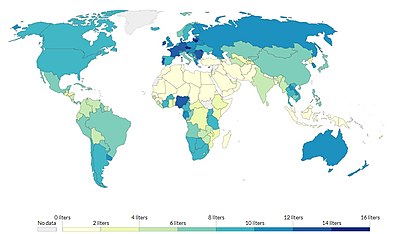
The average number of people who drink as of 2016[update] was 39% for males and 25% for females (2.4 billion people in total).[6] Females on average drink 0.7 drinks per day while males drink 1.7 drinks per day.[6] The rates of drinking varies significantly in different areas of the world.[6]
-
Age-standardised prevalence of current drinking for females (A) and males (B) in 2016, in 195 locations[6]
-
Average standard drinks (10 g of pure ethanol per serving) consumed per day, age-standardised, for females (A) and males (B) in 2016, in 195 locations[6]
Uses
Alcohol is used in rum-running, the illegal business of smuggling alcoholic beverages where such transportation is forbidden by law.
Moonshine is illegal to produce and sell in most countries.
A straw purchaser may receive money or recompense from the underage person in exchange for purchasing the alcohol on their behalf.
Alcohol has been used as a currency for transactional sex in South Africa, and Uganda.[42][43][44]
Food
Apéritifs and digestifs
An
Cooking
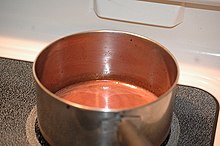
Pure ethanol tastes
Wine is important in cuisine not just for its value as an accompanying beverage, but as a flavor agent, primarily in
Food preservative
Alcohol has been used to preserve food.[50]
This section needs expansion. You can help by adding to it. (March 2024) |
Drinking food
Terms for foods always served with alcoholic beverages:
- Anju -- Korean term for drinking food
- Kap klaem -- Thai term for drinking food
- Sakana -- Japanese term for snacks served while drinking
Vinegar production
The source materials for making vinegar are varied – different fruits, grains, alcoholic beverages, and other fermentable materials are used:[53]
- Apple cider vinegar, or cider vinegar, is a vinegar made from cider.[54]
- Rice vinegar is a vinegar made from rice wine.
Wine and food matching
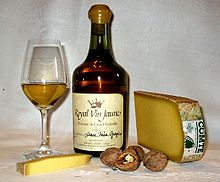
Offerings
Libation

A libation is a ritual pouring of a liquid, or grains such as rice, as an offering to a deity or spirit, or in memory of the dead. It was common in many religions of antiquity and continues to be offered in cultures today. Wine or other alcoholic drinks are often used for libation.
Libation was part of
Folk saints
Alcoholic beverages are typical offerings for the folk saints Maximón,[60] and Santa Muerte.[61][62] Both folk saints have been described as narco-saints.[63][64]
Religious
Sacramental wine in Christianity
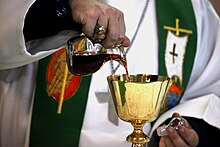
The amount of sacramental wine consumed during the Eucharist is typically limited to a single sip or small portion, which does not result in a measurable increase in the participant's blood alcohol content. This controlled and symbolic consumption of the sacramental wine is an integral part of the Eucharistic rite and does not lead to intoxication.
Catholic Church
According to the
§3 The wine must be natural, made from grapes of the vine, and not corrupt.[65]
Lutheranism
In Lutheranism, the Catechism teaches:[66]
289. What are the visible elements in the Sacrament?
The visible elements are bread and wine.
935. Matt. 26:26-27 Jesus took bread … Then He took the cup.
Note: “The fruit of the vine” (Luke 22:18) in the Bible means wine, not grape juice. See also 1 Cor. 11:21[66]
Some Evangelical Lutheran Church in America (ELCA) congregations make grape juice available for children and those who are abstaining from alcohol and some will accommodate those with an allergy to wheat, gluten, or grapes.[67]
Tasting
Beer tasting
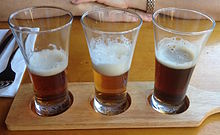
Beer tasting is a way to learn more about the history, ingredients, and production of beer, as well as different beer styles, hops, yeast, and beer presentation. A common approach is to analyze the appearance, smell, and taste of the beer, and then make a final judgment on the beer's quality. There are various scales used by beer journalists and experts to rate beer, such as the 1-20 scale used by British sommelier Jancis Robinson and the 1-100 scale used by American sommelier Joshua M. Bernstein. Professional organizations like the Wine & Spirit Education Trust often rate beer using verbal grades ranging from "faulty" to "outstanding" on a 1-5 scale.
Wine tasting
Wine tasting, on the other hand, is the sensory examination and evaluation of wine. While the practice of wine tasting is ancient, a more formalized methodology has been established since the 14th century. Modern, professional wine tasters use specialized terminology to describe the range of perceived flavors, aromas, and general characteristics of a wine. More informal, recreational tasting may involve similar terminology, but with a less analytical process and a more general, personal appreciation of the wine.
Tincture
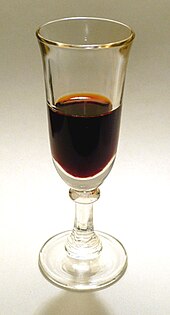
A
Other
Alcoholic beverage may be consumed to celebrate observances such as the International Beer Day.
Alcohol measurement
Alcohol concentration
| Fruit juices | < 0.1% |
| Cider, wine coolers | 4%–8% |
| Beers | typically 5% (range is from 3–15%) |
| Wines | typically 13.5% (range is from 8%–17%) |
| Sakes | 15–16% |
| Fortified wines | 15–22% |
| Spirits | typically 30%-40% (range is from 15% to, in some rare cases, up to 98%) |
The concentration of alcohol in a beverage is usually stated as the percentage of alcohol by volume (ABV, the number of milliliters (ml) of pure ethanol in 100 ml of beverage) or as proof. In the United States, proof is twice the percentage of alcohol by volume at 60 degrees Fahrenheit (e.g. 80 proof = 40% ABV). Degrees proof were formerly used in the United Kingdom, where 100 degrees proof was equivalent to 57.1% ABV. Historically, this was the most dilute spirit that would sustain the combustion of gunpowder.
Ordinary
Most yeasts cannot reproduce when the concentration of alcohol is higher than about 18%, so that is the practical limit for the strength of fermented drinks such as wine, beer, and sake. However, some strains of yeast have been developed that can reproduce in solutions of up to 25% ABV.[72]
Serving measures
Shot sizes
The shape of a glass can have a significant effect on how much one pours. A Cornell University study of students and bartenders' pouring showed both groups pour more into short, wide glasses than into tall, slender glasses.[74] Aiming to pour one shot of alcohol (1.5 ounces or 44.3 ml), students on average poured 45.5 ml & 59.6 ml (30% more) respectively into the tall and short glasses. The bartenders scored similarly, on average pouring 20.5% more into the short glasses. More experienced bartenders were more accurate, pouring 10.3% less alcohol than less experienced bartenders. Practice reduced the tendency of both groups to over pour for tall, slender glasses but not for short, wide glasses. These misperceptions are attributed to two perceptual biases:
- Estimating that tall, slender glasses have more volume than shorter, wider glasses; and
- Over-focusing on the height of the liquid and disregarding the width.
Standard drinks
There is no single standard, but a standard drink of 10g alcohol, which is used in the WHO AUDIT (Alcohol Use Disorders Identification Test)'s questionnaire form example,[75] have been adopted by more countries than any other amount.[76] 10 grams is equivalent to 12.7 millilitres.
A standard drink is a notional drink that contains a specified amount of pure alcohol. The standard drink is used in many countries to quantify alcohol intake. It is usually expressed as a measure of beer, wine, or spirits. One standard drink always contains the same amount of alcohol regardless of serving size or the type of alcoholic beverage. The standard drink varies significantly from country to country. For example, it is 7.62 ml (6 grams) of alcohol in Austria, but in Japan it is 25 ml (19.75 grams):
- In the United Kingdom, there is a system of unit of alcoholis defined as 10 ml. The number of units present in a typical drink is sometimes printed on bottles. The system is intended as an aid to people who are regulating the amount of alcohol they drink; it is not used to determine serving sizes.
- In the United States, the standard drink contains 0.6 US fluid ounces (18 ml) of alcohol. This is approximately the amount of alcohol in a 12-US-fluid-ounce (350 ml) glass of beer, a 5-US-fluid-ounce (150 ml) glass of wine, or a 1.5-US-fluid-ounce (44 ml) glass of a 40% ABV(80 US proof) spirit.
Laws
Alcohol laws regulate the manufacture, packaging, labelling, distribution, sale, consumption, blood alcohol content of motor vehicle drivers, open containers, and transportation of alcoholic drinks. Such laws generally seek to reduce the adverse health and social impacts of alcohol consumption. In particular, alcohol laws set the legal drinking age, which usually varies between 15 and 21 years old, sometimes depending upon the type of alcoholic drink (e.g., beer vs wine vs hard liquor or distillates). Some countries do not have a legal drinking or purchasing age, but most countries set the minimum age at 18 years.[3]
Some countries, such as the U.S., have the drinking age higher than the legal age of majority (18), at age 21 in all 50 states. Such laws may take the form of permitting distribution only to licensed stores,
In some jurisdictions, alcoholic drinks are totally prohibited for reasons of religion (e.g., Islamic countries with sharia law) or for reasons of local option, public health, and morals (e.g., Prohibition in the United States from 1920 to 1933). In jurisdictions which enforce sharia law, the consumption of alcoholic drinks is an illegal offense,[77] although such laws may exempt non-Muslims.[78]
Alcohol and health
It has been suggested that this article be merged into Alcohol (drug). (Discuss) Proposed since March 2024. |
Alcohol is a
.The short-term effects of alcohol consumption range from a decrease in anxiety and motor skills and euphoria at lower doses to intoxication (drunkenness), to stupor, unconsciousness, anterograde amnesia (memory "blackouts"), and central nervous system depression at higher doses. Cell membranes are highly permeable to alcohol, so once it is in the bloodstream, it can diffuse into nearly every cell in the body. Alcohol can greatly exacerbate sleep problems. During abstinence, residual disruptions in sleep regularity and sleep patterns are the greatest predictors of relapse.[68] Long-term use can lead to an alcohol use disorder, an increased risk of developing physical dependence. cardiovascular disease and several types of cancer.
The
A systemic metanalysis of 107 cohort studies concluded low daily alcohol intake gives neither harm nor benefit; however, increased consumption, even at relatively low levels of daily intake (>2 beverages for women and >3 beverages for men), does increase health and mortality risks.[83]
See also
- List of alcoholic drinks
- List of national drinks
- List of whisky brands
- List of rum brands
- List of tequilas
- List of vodka brands
- Liquor
- Beer and breweries by region
- List of barley-based drinks
- List of beer cocktails
- List of cocktails
- List of IBA official cocktails
- Beer and breweries by region
- Alcoholic beverage industry in Europe
- Alcohol (chemistry)
- Homebrewing
References
- ^ "Global status report on alcohol and health 2018". www.who.int.
- ISBN 978-1-139-45497-1.
'Drunkenness', at least in popular usage, he considered to be equivalent to 'intoxication'. Intoxication in turn, again according to popular usage, was understood as referring to 'the aggravated symptoms of alcoholic poisoning'. While recognising that intemperance was, in fact, 'indicative of sensual indulgence in general', he stated that in 'popular usage' it had gradually become narrowed in meaning to 'indulgence of the appetite for Strong Drink' or 'indulgence in some alcoholic drink'.
- ^ a b "Minimum Legal Age Limits". IARD.org. International Alliance for Responsible Drinking. Archived from the original on 4 May 2016. Retrieved 23 June 2016.
- ISBN 978-1-4473-0994-9.
- ^ PMID 32079559.
- ^ PMID 30146330.
- National Institute of Health. August 2018. Archived from the originalon 18 May 2015. Retrieved 8 October 2018.
- ^ Zielinski, Sarah (16 September 2011). "The Alcoholics of the Animal World". Smithsonian. Archived from the original on 22 August 2015. Retrieved 29 July 2015.
- ^ a b "No level of alcohol consumption is safe for our health". www.who.int. Archived from the original on 2023-01-12. Retrieved 2023-01-12.
- ISBN 978-0-404-04906-5.
- ^ "'World's oldest brewery' found in cave in Israel, say researchers". BBC News. 2018-09-15. Retrieved 2021-01-26.
- PMID 23560753.
- ISBN 978-0-313-35401-4.
- ISBN 978-0-415-89249-0.
- PMID 15590771.
- ^ Roach, John. "Cheers! Eight ancient drinks uncorked by science". Nbc News. Archived from the original on 4 April 2019. Retrieved 9 June 2013.
- PMID 29133421.
- ^ "The history and origins of cider". 13 February 2019. Archived from the original on 21 June 2021.
- ^ "The History of Cider". 25 April 2022. Archived from the original on 29 October 2022. Retrieved 29 October 2022.
- ^ Ancient Mashed Grapes Found in Greece Archived 3 January 2008 at the Wayback Machine Discovery News.
- ^ al-Hassan, Ahmad Y. (2009). "Alcohol and the Distillation of Wine in Arabic Sources from the 8th Century". Studies in al-Kimya': Critical Issues in Latin and Arabic Alchemy and Chemistry. Hildesheim: Georg Olms Verlag. pp. 283–298. (same content also available on the author's website Archived 2015-12-29 at the Wayback Machine); cf. Berthelot, Marcellin; Houdas, Octave V. (1893). La Chimie au Moyen Âge. Vol. I–III. Paris: Imprimerie nationale. vol. I, pp. 141, 143.
- ^ ISBN 978-90-04-00617-1. Archivedfrom the original on 23 January 2023. Retrieved 28 June 2010.
- ISBN 978-0-486-26298-7. pp. 51–52.
- ^ Whiskey: Technology, Production and Marketing: Handbook of Alcoholic Beverages Series p2 Academic Press 2003
- ^ Preventing Alcohol Abuse: Alcohol, Culture, and Control By David J. Hanson page 3
- ^ "America's History of Drinking". Alcohol.org.
- Houghton, Mifflin. p. 4.
- ^ "NOTABLE AUSTRALIAN EVENTS". The Sunday Times. No. 619. New South Wales, Australia. 7 November 1897. p. 9. Retrieved 25 February 2019 – via National Library of Australia.
- ^ Systembolaget.se About Systembolaget Archived 2007-10-18 at the Wayback Machine
- ISBN 978-0-415-31121-2. Archivedfrom the original on 23 January 2023. Retrieved 21 September 2010.
- ISBN 978-0-387-25495-1. Retrieved 29 July 2011.
- ^ Super, "Alcoholic Beverages", pp. 45–46.
- ^ "Distilled spirit/distilled liquor". Britannica. Archived from the original on 2008-05-09. Retrieved 2013-02-05.
- ^ Lichine, Alexis. Alexis Lichine's New Encyclopedia of Wines & Spirits (5th edition) (New York: Alfred A. Knopf, 1987), 707–709.
- ISBN 978-0-394-56262-9.
- ISBN 978-0-19-860990-2.
- ^ Understanding Congeners in Wine Archived 2013-06-13 at the Wayback Machine, Wines & Vines. Accessed 2011-4-20
- ^ Whisky hangover 'worse than vodka, a study suggests' Archived 2023-01-23 at the Wayback Machine, BBC News. Accessed 2009-12-19
- ^ "The 5 Basic Wine Characteristics". Wine Folly. 2012-07-23. Archived from the original on 2015-03-15. Retrieved 6 May 2015.
- ^ "Alcohol consumption per person". Our World in Data. Archived from the original on 16 March 2020. Retrieved 15 February 2020.
- PMID 37289839.
- PMID 33128109.
- PMID 19713023.
- S2CID 22424908.
- PMID 10940547.
- ^ "6 Secrets of Cooking with Wine". Archived from the original on 2017-03-22. Retrieved 2017-04-12.
- ISBN 978-1-4391-3997-4.
- ISBN 978-0-19-860990-2. See alcoholic strength at p. 10.
- ^ https://www.researchgate.net/publication/284830829.
{{cite web}}: Missing or empty|title=(help) - ^ "Acetic acid: general information". GOV.UK. Government Digital Service. Retrieved 19 March 2024.
- .
- ^ "Vinegar". TH Chan School of Public Health, Harvard University. 1 October 2019. Archived from the original on 14 November 2022. Retrieved 4 March 2020.
- ISBN 978-0-323-07295-3.
- ISBN 1-56305-434-5
- ISBN 978-0-7618-6710-4.
- ^ Delia, 1992, pp. 181-190[full citation needed]
- ^ James, George G. M. (1954). Stolen Legacy. New York: Philosophical Library.
- ^ Armah, Ayi Kwei (2006). The Eloquence of the Scribes: a memoir on the sources and resources of African literature. Popenguine, Senegal: Per Ankh. p. 207.
- ^ Meet Maximón: The Liquor-Drinking, Chain-Smoking Saint, National Geographic, Bethany Jones, January 24th, 2018
- ^ Araujo Peña, Sandra Alejandro; Barbosa Ramírez Marisela; Galván Falcón Susana; García Ortiz Aurea; Uribe Ordaz Carlos. "El culto a la Santa Muerte: un estudio descriptivo" [The Santa Muerte Cult:A descriptive study]. Revista Psichologia (in Spanish). Mexico City: Universidad de Londres. Retrieved 2009-10-07.
- ^ Villarreal, Hector (2009-04-05). "La Guerra Santa de la Santa Muerte" [The Holy War of Santa Muerte]. Milenio semana (in Spanish). Mexico City: Milenio. Archived from the original on 2009-10-16. Retrieved 2009-10-07.
- ^ Vincent, Isabel (21 December 2021). "Santa Muerte and five more 'religious' saints worshiped by drug cartels". New York Post. Retrieved 10 June 2022.
- ^ Flannagin, Jake (September 2014). "The Rise of the Narco-Saints". The Atlantic. Retrieved 10 June 2022.
- ^ Code of Canon Law, 1983 Archived 2006-06-19 at the Wayback Machine
- ^ a b Weber, Karl (31 May 2013). "Fruit of Which Vine?". Steadfast Lutherans. Retrieved 18 April 2024.
- ^ An example of a church that does. See the "Sunday Worship" section on the "Welcome" page.
- ^ a b c Groot Handboek Geneeskrachtige Planten by Geert Verhelst Cite error: The named reference "ReferenceA" was defined multiple times with different content (see the help page).
- ^ Ullian, Naomi (2016-09-19). "How To Make A Medicinal Mushroom Double-Extraction Tincture". Herbal Academy. Retrieved 2021-01-12.
- ^ "Find the Alcohol Contents of Beer, Wine, and Liquor". Archived from the original on 2 May 2015. Retrieved 6 May 2015.
- ^ Lichine, Alexis. Alexis Lichine's New Encyclopedia of Wines & Spirits (5th edition) (New York: Alfred A. Knopf, 1987), 365.
- ^ Stewart, Graham G. "Biographical Review: Seduced by Yeast". Journal of the American Society of Brewing Chemists (2015): 1–21. American Society of Brewing Chemists. 21 Jan. 2015. Web. 14 May 2017.
- ^ "fifedirect – Licensing & Regulations – Calling Time on Short Measures!". Fifefire.gov.uk. 2008-07-29. Archived from the original on 2011-07-22. Retrieved 2010-02-11.
- PMID 16373735.
- ^ "AUDIT The Alcohol Use Disorders Identification Test (Second Edition)" (pdf). WHO. 2001. Archived (PDF) from the original on 2022-01-20. Retrieved 2020-01-02.
- PMID 27073140.
- ^ Williams, Lizzie. Nigeria: The Bradt Travel Guide. p. 101.
- ^ Alcohol and Temperance in Modern History p. 329 David M. Fahey, Ian R. Tyrrell (2003)
- ^ Agents Classified by the IARC Monographs, Volumes 1–111 Archived 25 October 2011 at the Wayback Machine. monographs.iarc.fr
- ^ "Cancer warning labels to be included on alcohol in Ireland, minister confirms". Belfast Telegraph. 26 September 2018. Archived from the original on 11 April 2020. Retrieved 20 February 2023.
- ^ Chandler, Ellen (2012). "FASD - Fetal Alcohol Spectrum Disorder". White Ribbon Signal. 117 (2): 2.
- ^ Finn, Christina. "Irish Cancer Society urges minister not to drop proposed cancer warning labels on alcohol products". TheJournal.ie. Archived from the original on 2023-02-20. Retrieved 2023-02-20.
- ^ Bisognano, John (April 5, 2023). "Daily Alcohol Intake and Risk of All-Cause Mortality". American College of Cardiology.

